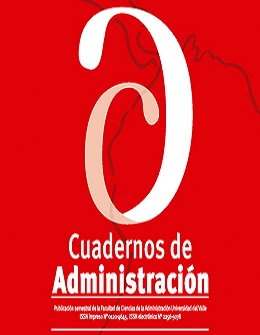State of the art on organizational longevity: a systematic literature review
Keywords:
Organizational Longevity, Strategy, Systematic Literature Review , Corporate Social ResponsibilityMain Article Content
Low business longevity is a worldwide phenomenon afflicting multiple organizations that operate in disparate economic conditions, across various industrial processes, different in size and disparate cultural environments. The opening and internationalization of the economy, as well as the problems associated with the environmental crisis, exacerbate this situation. The ability to adapt and strategic renewal of organizations thus become a fundamental capability to survive in times of globalization and competitiveness. The paper’s objective is to present the state of the art of organizational longevity based on a Systematic Literature Review in two databases (WOS and Scopus) with the help of two software specialized in bibliometric analysis and scientific mapping (Bibliometrix and VOSviewer). Organizational longevity is a growing and consolidating field since it addresses a core problem within management, economics, and the social sciences in general: survival. A trend starts to emerge, which hints at connections between the longevity of organizations and the corporate social responsibility (CSR) practices that they engage in.
Agarwal, R., Helfat, C. (2009). Strategic Renewal of Organizations. OrganizationScience, 20(2), 281-293. https://doi.org/10.1287/orsc.1090.0423 DOI: https://doi.org/10.1287/orsc.1090.0423
Ahmad, S., Omar, R., & Quoquab, F. (2019). Corporate Sustainable Longevity: Scale Development and Validation (pp. 1-19). SAGE Open. DOI: https://doi.org/10.1177/2158244018822379
Ahn, S.-Y., Park, D.-J. (2018). Corporate Social Responsibility and Corporate Longevity: The Mediating Role of Social Capital and Moral Legitimacy in Korea. Journal Business Ethics, 117-134. https://doi.org/10.1007/s10551-016-3161-3 DOI: https://doi.org/10.1007/s10551-016-3161-3
Aria, M., Cuccurullo, C. (. (2017). bibliometrix: An R-tool for comprehensive science mapping analysis. https://doi.org/10.1016/j.joi.2017.08.007 DOI: https://doi.org/10.1016/j.joi.2017.08.007
Ben-Menahem, S., Kwee, Z., & Volberda, H., &. (2013). Strategic Renewal Over Time: The Enabling Role of Potential Absorptive Capacity in Aligning Internal and External Rates of Change. Long Range Planning, 46, 216-235. http://www.elsevier.com/locate/lrp DOI: https://doi.org/10.1016/j.lrp.2012.09.012
Bohórquez, L. E. (2013). La organización empresarial como sistema adaptativo complejo. Estudios Gerenciales, 29(127), 258-265. http://dx.doi.org/10.1016/j.estger.2013.05.014 DOI: https://doi.org/10.1016/j.estger.2013.05.014
Box, M. (2008). The death of firms: exploring the effects of environment and birth cohort on firm survival in Sweden. Small Business Economics, 31(4), 379-393. https://doi.org/10.1007/s11187-007-9061-2 DOI: https://doi.org/10.1007/s11187-007-9061-2
Burgelman, R., Grove, A. (2007). Let chaos reign, then rein in chaos - Repeatedly: Managing strategic dynamics for corporate longevity. Strategic Management Journal, 28(10), 905-979. https://doi.org/10.1002/smj.625 DOI: https://doi.org/10.1002/smj.625
Chanlat, A. (1988). Las ciencias de la vida y la gestión administrativa. Cuadernos de Administración, 10(14), 26-34. https://doi.org/10.25100/cdea.v10i14.293 DOI: https://doi.org/10.25100/cdea.v10i14.293
Confecámaras. (2016). Nacimiento de las empresas en Colombia. https://www.confecamaras.org.co/phocadownload/
Confecámaras. (2017). Determinantes de la supervivencia empresarial en Colombia. https://www.confecamaras.org.co/phocadownload/
Confecámaras. (2018). Nuevos hallazgos de la supervivencia y crecimiento de las empresas en Colombia.
Costanza, D., Blacksmith, N., Coats, M., Severt, J., & DeCostanza, A. (2016). The Effect of Adaptive Organizational Culture on Long-Term. Bus Psychol, (31), 361-381. https://doi.org/10.1007/s10869-015-9420-y DOI: https://doi.org/10.1007/s10869-015-9420-y
Daepp, M., Hamilton, M., West, G., & LMA, B. (2015). The mortality of companies. Interface, 1-8. http://dx.doi.org/10.1098/rsif.2015.0120 DOI: https://doi.org/10.1098/rsif.2015.0120
Dery, R. (2004). Homo Administrativus y su doble, en busca del saber. AD-minister, (5), 86-125. https://www.semanticscholar.org/paper/Homo-Administrativus-y-su-doble%2C-en-busca-del-saber-D%C3%A9ry/835e18293fc36eeed2e3d1bf27d18d46e1aa537a
Driel, H., Volberda, H. W., Eikelboomb, S., & Kamerbeek, E. (2015). A co-evolutionary analysis of longevity: Pakhoed and its predecessors. Business History, 1277-1305. http://dx.doi.org/10.1080/00076791.2015.1026261 DOI: https://doi.org/10.1080/00076791.2015.1026261
Dzikowski, P. (2018). A bibliometric analysis of born global firms. Journal fo Business Research, 281-294. https://doi.org/10.1016/j.jbusres.2017.12.054 DOI: https://doi.org/10.1016/j.jbusres.2017.12.054
Geus, A. (1997). La empresa viviente, hábitos para sobrevivir en el turbulento mundo de los negocios. Harvard Business Press.
Grashuis, J. (2018). An Exploratory Study of Cooperative Survival: Strategic Adaptation to External Developments. Sustainability, 10(3), 15. https://doi.org/10.3390/su10030652 DOI: https://doi.org/10.3390/su10030652
Hannan, F., Freeman, J. (1984). Structural Inertia and Organizational Change. American Sociological Review, 49(2), 149-164. DOI: https://doi.org/10.2307/2095567
Kwee, Z. (2009). Investigating Three Key Principles of Sustained Strategic Renewal, A Longitudinal Study of Long-Lived Firms. Erasmus University Rotterdam.
Kwee, Z., Bosch, F. V., & Volberda, H. W. (2011). The Influence of Top Management Team’s Corporate Governance Orientation on Strategic Renewal. Journal of Management Studies, 48(5), 984-1014. https://doi.org/10.1111/j.1467-6486.2010.00961.x DOI: https://doi.org/10.1111/j.1467-6486.2010.00961.x
Mayfield, M., Mayfield, J., & & Stephens, D. (2007). The relationship of generic strategy typing and organizational longevity. Competitiveness Review, 17(1/2), 94-109. https://doi.org/10.1108/10595420710816641 DOI: https://doi.org/10.1108/10595420710816641
Montuori, L. (2000). Organizational longevity Integrating systems thinking, learning and conceptual complexity. Journal of Organizational Change Management, 61-73. https://doi.org/10.1108/09534810010310249 DOI: https://doi.org/10.1108/09534810010310249
Napolitano, M., Marino, V., & Ojala, J. (2015). In search of an integrated framework of business longevity. Business History, 57(7), 955-969. http://dx.doi.org/10.1080/00076791.2014.993613 DOI: https://doi.org/10.1080/00076791.2014.993613
Parris, D., Peachey, J. (2013). A systematic lterature review of servant leadership Theory in organizational contexts. Business Ethics, 377-393. https://doi.org/10.1007/s10551-012-1322-6 DOI: https://doi.org/10.1007/s10551-012-1322-6
Piao, M. (2014). A long life after exploitation and exploration. European Journal of Innovation, 17(2), 209-228. https://doi.org/10.1108/EJIM-09-2013-0087 DOI: https://doi.org/10.1108/EJIM-09-2013-0087
Riviezzo, A., Skippari, M., & Garofano, A. (2015). Who wants to live forever: exploring 30 years of research on business Longevity. Business History, 970-987. http://dx.doi.org/10.1080/00076791.2014.993617 DOI: https://doi.org/10.1080/00076791.2014.993617
Sahut, J.-M., Bouleme, S., Mili, M., & Teulon, F. (2012). what relation exists between corporate social responsability and longevity of firms? International Journal of Business, 152-162.
Saunders, M., Lewis, P., & Thornhill, A. (2016). Research Methods for Business Students. Pearson Education Limited.
Schneider, M., Somers, M. (2006). Organizations as complex adaptive systems: Implications of Complexity Theory for leadership research. The Leadership Quarterly, 17(4), 351-365. https://doi.org/10.1016/j.leaqua.2006.04.006 DOI: https://doi.org/10.1016/j.leaqua.2006.04.006
Schmitt, A., Barker III, V. L., Raisch S., & Whetten, D. (2016). Strategic Renewal in Times of Environmental Scarcity. Long Range Planning, 49(3), 361-376. https://doi.org/10.1016/j.lrp.2015.08.004 DOI: https://doi.org/10.1016/j.lrp.2015.08.004
Scott, R. (2003). Organizations. Rational, Natural, and Open Systems. Pearson Education, Inc.
Velásquez, J. D. (2015). Una Guía Corta para Escribir Revisiones Sistemáticas de Literatura. DYNA, 82(189)9-10. https://doi.org/10.15446/dyna.v82n189.48931 DOI: https://doi.org/10.15446/dyna.v82n189.48931
Volberda, H., Lewin, A. (2003). Co-evolutionary dynamics within and between firms: from evolution to co-evolution. Journal of Management Studies, 40(8), 2111-2136. https://doi.org/10.1046/j.1467-6486.2003.00414.x DOI: https://doi.org/10.1046/j.1467-6486.2003.00414.x
Zupic, I., Câter, T. (2015). Bibliometric methods in management and organization. Organizational Research Methods, 18(3), 429-472. https://doi.org/10.1177/1094428114562629 DOI: https://doi.org/10.1177/1094428114562629
Downloads

This work is licensed under a Creative Commons Attribution-NonCommercial-NoDerivatives 4.0 International License.

